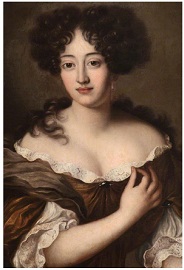LINDA PORTER


end of his reign
Charles had fathered thirteen illegitimate children but no legitimate heir
with his wife, the Portuguese princess, Catherine of Braganza. She had suffered
two miscarriages and was always loyal and loving, despite her incorrigible
husband’s behaviour. Often depicted as a dismal little figure taking
refuge in religion, recent research has shown how Catherine effectively
forged an independent existence and was an important patron of the arts
as well as a
His last mistress
was the flamboyant and distractingly beautiful Italian bisexual, Hortense
Mancini, niece of Cardinal Mazarin, France’s chief minister. By the

But she was never
entirely secure. Charles had wandering eyes and wandering hands, as
the fifteen-year-old ingenue, Frances Teresa Stuart, found out soon after
she arrived from France as an apparently giggly, empty-headed maid of honour,
‘the prettiest girl in the world,’ as Charles’s sister,
Minette, described her. After four years fighting off the king’s advances
she eloped with the duke of Richmond and enjoyed a happy marriage,
much to the king’s initial displeasure.
He was not unhappy for long. The wily, prim Breton aristocrat, Louise de Kéroualle, lost her virginity to Charles in 1671 and became his most durable mistress, courted by politicians who believed she had great influence with the king. The French were not so sure, but hoped to use her services as a spy
He was not unhappy for long. The wily, prim Breton aristocrat, Louise de Kéroualle, lost her virginity to Charles in 1671 and became his most durable mistress, courted by politicians who believed she had great influence with the king. The French were not so sure, but hoped to use her services as a spy


nevertheless. Never
one to feel restricted by convention, Charles was also bedding the cheerfully
vulgar comedy actress, Nell Gwyn, the most well-known of his mistresses,
though not the most significant. And still he was not finished.


If you like the six wives of Henry VIII, you’ll be captivated by
the mistresses of Charles II. Six of these ladies – and his
long-suffering, underestimated wife, Catherine of Braganza –
feature in my new book, ‘Mistresses: sex and scandal at the court
of Charles II’.
It was while in exile at The Hague, having fled from the Civil Wars which would culminate in his father’s execution, that Charles met a seductive good-time girl from Wales, Lucy Walter. Theirs was a brief liaison, probably no more than a few nights of summer passion between teenagers, but it would have lifelong implications. Lucy claimed they had gone through a form of marriage, which would have made their son, James, later duke of Monmouth, Charles’s legitimate heir.
It was while in exile at The Hague, having fled from the Civil Wars which would culminate in his father’s execution, that Charles met a seductive good-time girl from Wales, Lucy Walter. Theirs was a brief liaison, probably no more than a few nights of summer passion between teenagers, but it would have lifelong implications. Lucy claimed they had gone through a form of marriage, which would have made their son, James, later duke of Monmouth, Charles’s legitimate heir.
The king, restored
in 1660, always denied that he had wed Lucy but the rumour would not go
away and led to a political crisis about the succession in the late 1670s.
Charles quickly tired of Lucy, finding her poor judgement and constant demands
for money an embarrassment. By the time of his restoration, the tally of
mistresses was growing, but it was the woman he met soon after his return
to England who would dominate him for the next decade. The sexually voracious
and financially greedy Barbara Villiers’ affair with the king was
the talk of London. Neither cared. In fact, the passionate, auburn-haired
Barbara revelled in her notoriety, flaunting her jewels, titles and wealth
and producing five children with the king.
trend-setter in furnishings
and tea-drinking.
Against a backdrop of plague, fire and ice, when England was humiliated abroad and bitterly divided at home, these women held centre stage. Their stories reveal the heart of a court as colourful as it was corrupt. The eagerly admired celebrities of their day, these women were the glittering stars of Restoration England.
Against a backdrop of plague, fire and ice, when England was humiliated abroad and bitterly divided at home, these women held centre stage. Their stories reveal the heart of a court as colourful as it was corrupt. The eagerly admired celebrities of their day, these women were the glittering stars of Restoration England.